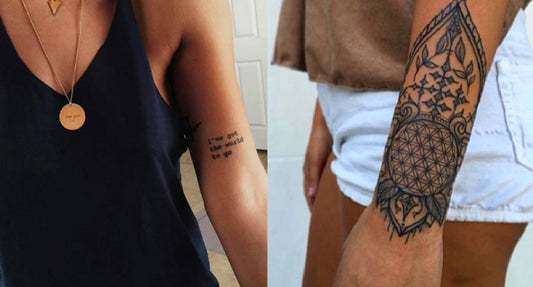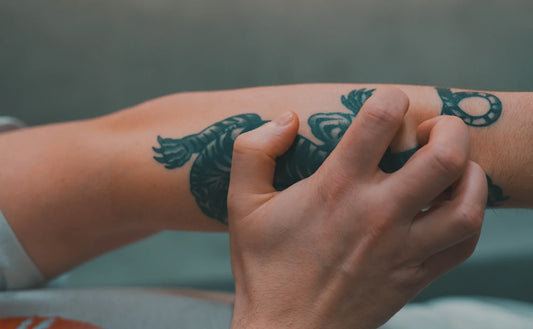
Swimming With Fresh Tattoos: Everything You Need to Know
While frolicking on the beach or at the pool may seem like the perfect opportunity to showcase some fresh ink, don't put on the swimsuit just yet.
Before swimming in any kind of water, you should wait for your tattoo to fully heal, which can take up to four weeks.
1. The importance of waiting
You should give your tattoo time to heal before swimming for your health as well as your new body art.
Swimming with a newly healed tattoo can result in the following consequences.
Infection risk
The risk of infection makes it not recommended to immerse freshly tattooed skin, aside from gentle washing.
A new tattoo is essentially an open wound, so submerging it in water could potentially expose it to harmful bacteria. There is a wide range of severity when it comes to infections.
It is possible to develop sepsis and die from it. A man who had a new tattoo when he swam in the Gulf of Mexico contracted Vibrio vulnificus (also known as the flesh-eating bacteria).
In chlorinated swimming pools, the risk of bacteria spreading may be lower than in open water, such as a lake or ocean, but chlorine doesn't kill all bacteria.
Damage to your tattoo
It is also possible for your new tattoo to fade and discolor after soaking in water. Ink can be leached from fresh tattoos by chlorine and salt water, resulting in less vibrant colors.
Additionally, swimming can dry out your skin and prolong healing, leading to more itchiness, flaking, and scabbing. Also, the lines may become blurry, fade, or patchy due to this.
Skin irritation
In any case, some skin irritation is to be expected with a new tattoo. A gnarly infection or damaging your new and expensive art doesn't sound nearly as bad.
It is true that skin irritation can contribute to both of those risks, not to mention that it can be extremely uncomfortable as well.
The skin of a newly tattooed person is already raw and sensitive. It may cause irritant contact dermatitis if exposed to chlorine and other chemicals. Inflammation of the skin is caused by chemicals like chlorine that penetrate the skin.
Symptoms may include blistering, open sores, crusting, swelling, and red itchy rashes - all of which can affect your tattoo's appearance.
2. The best way to tell if your tattoo has fully healed
It can be difficult to determine whether your tattoo has fully healed. It may look and feel healed within a few days - at least on the surface.
Tattoo artists usually consider tattoos healed within 2–4 weeks, but it depends on the size and location of the piece. The healing process of a tattoo can take up to six months.
Healing time can also be affected by factors such as your lifestyle and how diligent you are with aftercare.
As soon as your tattoo stops being red, itchy, scabbing, or flaking, you can consider it completely healed.
Let a professional check your tattoo if you aren't sure. You can do so by going to the studio where your tattoo was done.

3. If you have to swim
Here are a few steps you can take to help protect your tattoo if you have to expose it to water for some reason, like physical therapy or rehab.
Put on a waterproof dressing
Submerging your new tattoo in water can damage it, so you should use a waterproof dressing. There are different sizes of sheets and rolls available.
Ensure that your tattoo is completely covered. Apply the bandage just before you get in the water and remove it as soon as you're done.
It is better to keep a healing tattoo covered for as little time as possible so as not to interfere with the healing process.
Clean the tattoo as soon as you’re done
To prevent water from running over your skin, pat your skin dry before removing the bandage. Use mild soap and warm water to gently wash the tattoo after removing the bandage.
With a clean paper towel, gently pat your tattoo dry.
4. If you already went swimming
So... you went swimming with fresh ink without taking any precautions? You don't need to panic. The one death mentioned above is obviously concerning, but it isn't a common occurrence.
However, you should keep an eye out for any signs of trouble.
After getting a tattoo, you may experience some redness, tenderness, and peeling. However, if these things continue or worsen, there may be a problem.
When a tattoo stays wet for too long, it can degrade, causing bubbles. Consult your tattoo artist if you notice any signs of tattoo degradation. There is also the possibility of fade and scarring.
RED FLAGS
If you experience any of the following symptoms of infection, you should see a healthcare professional immediately:
- continued or worsening redness
- redness that’s spreading out from the tattoo
- skin that feels hot to the touch
- pain that’s severe or worsening
- rash or blistering
- open sores on and around your tattoo
- smelly discharge or pus from the tattoo
- bleeding
- fever
- chills
5. Conclusion
There is a good reason why swimming with a fresh tattoo is not recommended. In addition to ruining your tattoo, it could also increase your chances of contracting an infection.
Whenever possible, try to avoid swimming and follow all your artist's aftercare instructions.










